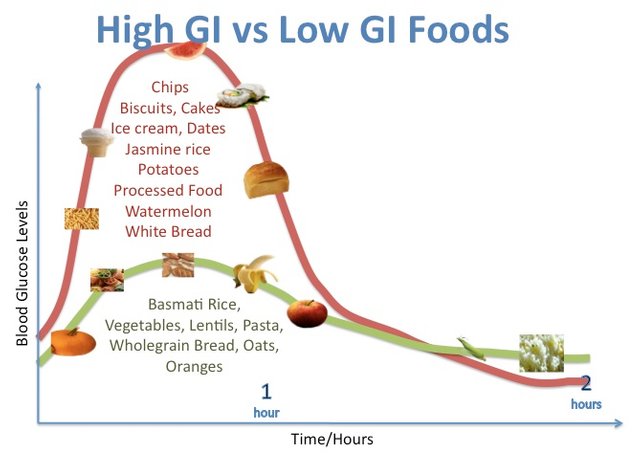Glycemic Index (GI) & Glycemic Load (GL) Explained!
What is Glycemic Index & Glycemic Load. How Are They Different & Why They Are Important?

[Image via https://blogs.commons.georgetown.edu]
Glycemic Index [GI] Explained
The Glycemic Index is a number that can be associated with most foods. The number is an indicator of the effect that food has on your blood glucose level, also known as blood sugar level. The GI represents the rise in a person's blood sugar level two hours after consumption of the food. The higher the number the more effect that food has on your blood glucose level.
Once you start researching the GI of some of the common foods you eat you will get a sense of what is high and what is low in the context of the foods that are part of your current diet. I encourage you to do this.
Glycemic Load [GL] Explained
The Glycemic Load is a number that can be associated with most foods, and in my opinion is more relevant than GI. Because Glycemic Index does not take into consideration that some foods are consumed in larger or smaller portion sizes than other foods, a food may be listed as having a high GI, but because only a small amount of that food is typically eaten at one time, the total amount of carbohydrates from sugar will have a minimal impact on your blood sugar levels.
A common example is Watermelon, which is high on the GI with a score of 72 [Anything above 70 is High], but has a Low Glycemic Load of only 3. This is because typically you may enjoy a single slice of watermelon or a serving of around 1 cup, which will typically contain around 9 grams of sugar. Likely not enough to trigger a large blood sugar spike. Just don't go eating the entire watermelon!
So why is the Glycemic Index important?
It's important because foods with a high GI create a spike in your blood sugar level which triggers your body to produce insulin which goes to work to break down the sugars in your blood. After you eat, carbohydrates break down into glucose, a sugar that serves as a primary source of energy, and enters the bloodstream.
Constant spikes in your blood sugar level over time can lead to what's known as insulin resistance. This is when your body's muscle, fat, and liver cells no longer respond properly to insulin and therefor cannot easily absorb glucose from the bloodstream. Uh-oh that doesn't sound good, and it's not. Insulin Resistance can lead to Type 2 Diabetes and prediabetes.
Here are some foods and where they rank on the GI, take a look:

[Image via http://dailyhealthyfoodtips.com]
Any questions or comments, please leave them below and we can discuss!
Until next time..

Very nice blog and easily digested info @agr8buzz keep up the good content!